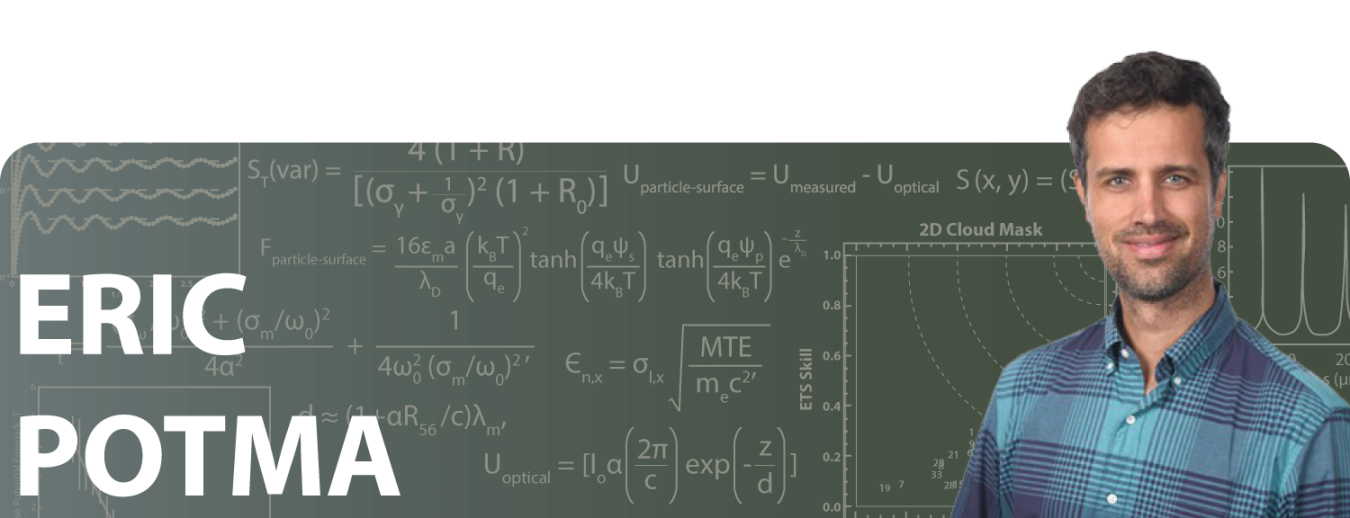University of California, Irvine’s Eric Potma has developed a method and device for observing electrons on the femtosecond time scale.
April 24, 2020
WHAT DID THE 2010 EARLY CAREER AWARD ALLOW YOU TO DO?
The motility of electrons within a molecule is at the very heart of chemistry. Moving electrons drive molecular reactions and allow electrical conductance. Despite the fundamental nature of electron flow within molecules, it has remained extraordinarily difficult to measure the exact spatial and temporal electron dynamics in molecular systems.
One of the difficulties stems from the fact that such motion is random. Electron flow across an ensemble of molecules can be measured as an average, but the actual mechanism of electron motion through a single molecule remains unseen.
Another difficulty is that electron motion is fast - too fast to capture with standard electronic instruments. To understand electron motion in molecules, a fast electron camera is needed for recording the motion of a single electron through a molecule.
This Early Career Award made it possible to develop a method for catching the electron in the act of traversing a molecule. A special nanoscale device was fabricated, which allows the launching of individual electrons across a gap the size of a molecule at precisely controlled times. This device makes it possible to observe the electron as it flows through a molecule on the femtosecond time scale.
ABOUT:
Eric O. Potma is a professor in the Department of Chemistry at the University of California, Irvine (UCI). He holds adjunct positions in the Department of Electrical Engineering and Computer Sciences, and in the Beckman Laser Institute at UCI.
SUPPORTING THE DOE SC MISSION:
The Early Career Award program provides financial support that is foundational to young scientists, freeing them to focus on executing their research goals. The development of outstanding scientists early in their careers is of paramount importance to the Department of Energy Office of Science. By investing in the next generation of researchers, the Office of Science champions lifelong careers in discovery science.
For more information, please go to the Early Career Research Program.
THE 2010 PROJECT ABSTRACT:
Ultrafast electron transport across nonogaps in nanowire circuits
The objective of this project is to overcome the experimental challenges that have held back ultrafast, time‐resolved optical experiments on single molecules. By zooming in on ultrafast timescales at which molecular motions are coupled to moving charges, the findings will ultimately guide the design of electronics components of relevance to many facets of energy generation and utilization, including solar energy conversion and energy storage. Detailed knowledge of how molecular structure relates to conductivity and charge storage is imperative to the design of devices at the level of a single molecule and includes an understanding of how molecular orbitals participate in the electron transport, which structural changes occur during molecular charging, and what timescales are important for these processes. To this end, the field of molecular electronics will be combined with ultrafast microscopy to study electron transport in single molecules at ultrafast time scales.
RESOURCES:
Wang, Y., Liu, X., Whitmore, D., Xing, W. X, and Potma, E.O., “Remote multi-color excitation using femtosecond propagating surface plasmon polaritons in gold films.” Opt. Express 19, 13454 (2011). [DOI: 10.1364/OE.19.013454]
Brocious, J. and Potma, E.O., “Lighting up micro-structured materials with four-wave mixing microscopy.” Materials Today 16, 344-350 (2013). [DOI: 10.1016/j.mattod.2013.08.001]
Albee, B., Liu, X., Ladani, F.T., Dutta, R.K., and Potma, E.O., "Distance-dependent photo-induced electron transport in nanometer-sized junctions." J. Opt. 18 (5), 054004 (2016). [DOI: 10.1088/2040-8978/18/5/054004]
DOE Explains… offers straightforward explanations of key words and concepts in fundamental science. It also describes how these concepts apply to the work that the Department of Energy’s Office of Science conducts as it helps the United States excel in research across the scientific spectrum. For more information on ultrafast science and DOE’s research in this area, please go to “DOE Explains…Ultrafast Science.”
Additional profiles of the Early Career Research Program award recipients can be found on the Early Career Program Page.
The Office of Science is the single largest supporter of basic research in the physical sciences in the United States and is working to address some of the most pressing challenges of our time. For more information, please visit www.energy.gov/science.
Sandra Allen McLean

Sandra Allen McLean ([email protected]) is a communications specialist for the Office of Science in the Office of Communications and Public Affairs. Sandra is responsible for identifying, curating, or creating lay-language content about Office of Science-funded research for DOE web sites, popular and trade media, and stakeholder education. She researches and writes the historical Milestone Tweets for the office Twitter account @DOEScience.
Sandra holds an associate degree in American Sign Language interpreting, a bachelor’s in science journalism and biology, and a master’s in Information Sciences. Her hobbies are sewing – especially costumes! – and lesesucht, compounded by extreme tsundoku.

